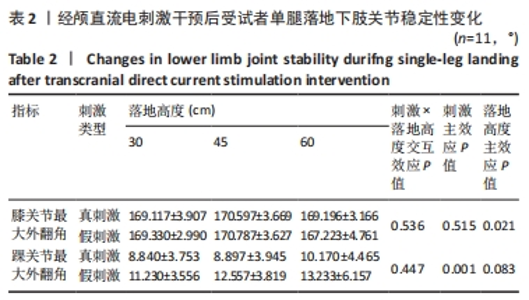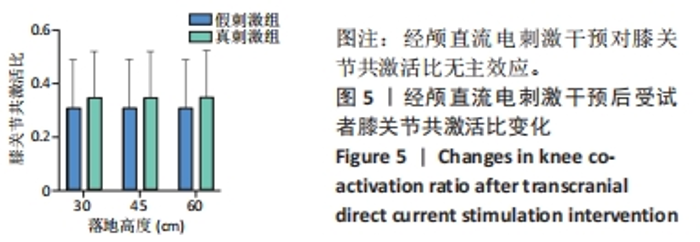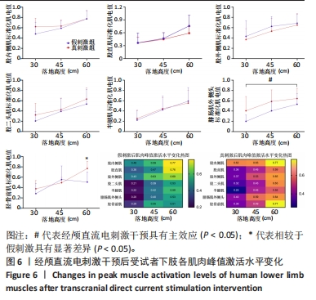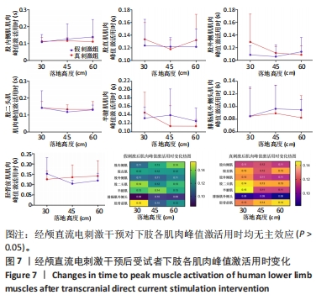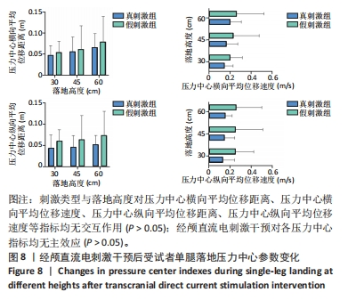Chinese Journal of Tissue Engineering Research ›› 2024, Vol. 28 ›› Issue (26): 4209-4215.doi: 10.12307/2024.439
Previous Articles Next Articles
Effect of transcranial direct current stimulation on human single-leg landing stability
Lin Qinzhao1, Wei Mengli1, 2, Zhong Yaping1, 2, Wu Qian1, Zhou Botao1, Wang Haifeng1
- 1Sports Big Data Research Center of Wuhan Sports University, Wuhan 430079, Hubei Province, China; 2Hubei Sports and Health Innovation and Development Research Center, Wuhan 430079, Hubei Province, China
-
Received:2023-07-08Accepted:2023-08-07Online:2024-09-18Published:2023-10-07 -
Contact:Zhong Yaping, PhD, Doctoral supervisor, Sports Big Data Research Center of Wuhan Sports University, Wuhan 430079, Hubei Province, China; Hubei Sports and Health Innovation and Development Research Center, Wuhan 430079, Hubei Province, China -
About author:Lin Qinzhao, Master candidate, Sports Big Data Research Center of Wuhan Sports University, Wuhan 430079, Hubei Province, China Wei Mengli, Doctoral candidate, Sports Big Data Research Center of Wuhan Sports University, Wuhan 430079, Hubei Province, China -
Supported by:Education Reform Project of Hubei Province, No. 2022395 (to ZYP); Decision-making Consultation Research Project of General Administration of Sport of China, No. 2023-B-19 (to ZYP); Key Project Funded by the National Social Science Fund, No. 22FTYA001 (to ZYP)
CLC Number:
Cite this article
Lin Qinzhao, Wei Mengli, Zhong Yaping, Wu Qian, Zhou Botao, Wang Haifeng. Effect of transcranial direct current stimulation on human single-leg landing stability[J]. Chinese Journal of Tissue Engineering Research, 2024, 28(26): 4209-4215.
share this article
Add to citation manager EndNote|Reference Manager|ProCite|BibTeX|RefWorks
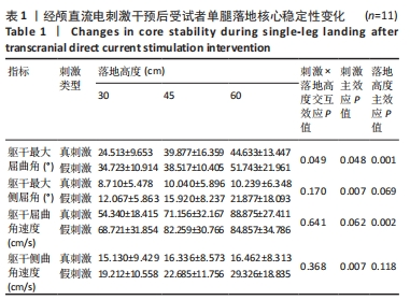
2.1 参与者数量分析 研究所招募的11名受试者均完成所有测试,测试结果均为有效,全部数据进入结果分析。 2.2 tDCS干预后受试者单腿落地核心稳定性变化 研究结果显示,tDCS干预与落地高度对躯干最大屈曲角具有交互效应(F=3.541,P=0.018),经成对比较分析发现,在30 cm落地高度条件下,相较于假刺激,tDCS真刺激后受试者躯干最大屈曲角显著降低,差值为(10.210±1.796)°;此外,tDCS干预对躯干最大侧屈角具有主效应(F=12.131,P=0.007)、对躯干侧屈角速度具有主效应(F=12.318,P=0.007),相较于假刺激,tDCS真刺激干预后受试者躯干最大侧屈角显著变小,躯干侧屈角速度显著降低,见表1。"

| [1] 芦劼明,郑晓丹,刘悦,等.屈膝肌疲劳对单腿落地时下肢生物力学指标的影响[J].中国运动医学杂志,2022,41(2):101-108. [2] 周志鹏,曲峰,刘鹏,等.不同方向单腿跳跃落地及运动疲劳对非接触性前交叉韧带损伤风险的影响[J].中国体育科技,2017,53(1):111-117. [3] HEWETT TE, TORG JS, BODEN BP. Video analysis of trunk and knee motion during non-contact anterior cruciate ligament injury in female athletes: lateral trunk and knee abduction motion are combined components of the injury mechanism. Br J Sports Med. 2009;43(6):417-422. [4] KOGA H, NAKAMAE A, SHIMA Y, et al. Mechanisms for non-contact anterior cruciate ligament injuries: knee joint kinematics in 10 injury situations from female team handball and basketball. Am J Sports Med. 2010;38(11):2218-2225. [5] TAYLOR JB, FORD KR, NGUYEN AD, et al. Biomechanical comparison of single- and double-leg jump landings in the sagittal and frontal plane. Orthop J Sports Med. 2016;4(6):1-9. [6] LAUGHLIN WA, WEINHANDL JT, KERNOZEK TW, et al. The effects of single-leg landing technique on ACL loading. J Biomech. 2011;44(10):1845-1851. [7] BROWN TN, MCLEAN SG, PALMIERI RM. Associations between lower limb muscle activation strategies and resultant multi-planar knee kinetics during single leg landings. J Sci Med Sport. 2014;17(4):408-413. [8] LEPORACE G, PEREIRA GR, NADAL J, et al. Differences in time-frequency representation of lower limbs myoelectric activity during single and double leg landing in male athletes. J Electromyogr Kinesiol. 2011;21(3):506-511. [9] ZAMBARANO EK, BOUILLON L, GLAVIANO NR. Relationship between lumbopelvic-hip complex stability, muscle activity, and 2-dimensional kinematics of the trunk and lower extremity. Phys Ther Sport. 2021;(47):7-14. [10] MOGHADAM M, ASHAYERI H, SALAVATI M, et al. Reliability of center of pressure measures of postural stability in healthy older adults: effects of postural task difficulty and cognitive load. Gait Posture. 2011;33(4):651-655. [11] KUNI B, MUSSLER J, KALKUM E, et al. Effect of kinesiotaping, non-elastic taping and bracing on segmental foot kinematics during drop landing in healthy subjects and subjects with chronic ankle instability. Physiotherapy. 2016;102(3):287-293. [12] SARVESTAN J, NEEDLE AR, ATAABADI PA, et al. Acute effect of ankle kinesio™ taping on lower-limb biomechanics during single-legged drop landing. J Sport Rehabil. 2020;30(5):689-696. [13] KWON YJ, PARK SJ, JEFFERSON J, et al. The effect of open and closed kinetic chain exercises on dynamic balance ability of normal healthy adults. J Phys Ther Sci. 2013;25(6):671-674. [14] NAGELLI C, DI STASI S, TATARSKI R, et al. Neuromuscular training improves self-reported function and single-leg landing hip biomechanics in athletes after anterior cruciate ligament reconstruction. Orthop J Sports Med. 2020;8(10):1-7. [15] HUANG CY, HSIEH TH, LU SC, et al. Effect of the Kinesio tape to muscle activity and vertical jump performance in healthy inactive people. Biomed Eng OnLine. 2011;10(1):10-70. [16] LINS CA, NETO FL, AMORIM AB, et al. Kinesio Taping(®) does not alter neuromuscular performance of femoral quadriceps or lower limb function in healthy subjects: randomized, blind, controlled, clinical trial. Man Ther. 2013; 18(1):41-45. [17] HOPPER AJ, HAFF EE, JOYCE C, et al. Neuromuscular training improves lower extremity biomechanics associated with knee injury during landing in 11-13 year old female netball athletes: a randomized control study. Front Physiol. 2017;(8):1-13. [18] 卞秀玲,王雅娜,王开元,等.经颅直流电刺激技术及其在提升运动表现中的应用[J].体育科学,2018,38(5):66-72. [19] 刘盼,刘世文.经颅直流电刺激的研究及应用[J].中国组织工程研究与临床康复,2011,15(39):7379-7383. [20] 肖松林,周俊鸿,王宝峰,等.高精度经颅直流电刺激对足部肌肉力量,踝关节运动觉及静态平衡的影响[J].体育科学,2020,40(5):42-51. [21] YI D, SUNG YJ, YIM JE. Effect of transcranial direct current stimulation on walking speed, functional strength, and balance in older adults: a randomized, double-blind controlled trial. Med Sci Monit. 2021;27:1-17. [22] KAMINSKI E, STEELE CJ, HOFF M, et al. Transcranial direct current stimulation (tDCS) over primary motor cortex leg area promotes dynamic balance task performance. Clin Neurophysiol. 2016;127(6):2455-2462. [23] 乔淇淇,吴翊馨,王新,等.高精度经颅直流电刺激对人体动态平衡能力的影响[J].中国组织工程研究,2022,26(26):4192-4198. [24] GRUEVA-PANCHEVA T. Original article effect of proprioceptive training on postural balance in patients with chronic ankle instability. JPES. 2021;21(1):3-11. [25] SHUN K, AKIHIKO M, NARUTO Y, et al. Postural stability and lower leg muscle activity during a diagonal single-leg landing differs in male collegiate soccer players with and without functional ankle instability. JPFSM. 2017;6(4):257-265. [26] GARCIA M, CHULVI I, MAROTO S, et al. Effects of preceding transcranial direct current stimulation on movement velocity and EMG signal during the back squat exercise. J Clin Med. 2022;11(17):5220-5232. [27] SHAW MY, GRIBBLE PA, FRYE JL. Ankle bracing, fatigue, and time to stabilization in collegiate volleyball athletes. J Athl Train. 2008;43(2):164-171. [28] GRIBBLE PA, TAYLOR BL, SHINOHARA J. Bracing does not improve dynamic stability in chronic ankle instability subjects. Phys Ther Sport. 2010;11(1):3-7. [29] FUJII M, SATO H, TAKAHIRA N. Muscle activity response to external moment during single-leg drop landing in young basketball players: the importance of biceps femoris in reducing internal rotation of knee during landing. J Sports Sci Med. 2012;11(2):255-259. [30] FAGENBAUM R, DARLING WG. Jump landing strategies in male and female college athletes and the implications of such strategies for anterior cruciate ligament injury. Am J Sports Med. 2003;31(2):233-240. [31] SAITO A, OKADA K, SASAKI M, et al. Influence of the trunk position on knee kinematics during the single-leg landing: implications for injury prevention. Sports Biomech. 2022;21(7):810-823. [32] MANIAR N, SCHACHE AG, PIZZOLATO C, et al. Muscle function during single-leg landing. Sci Rep. 2022;12(1):1-14. [33] 魏梦力,钟亚平,吕一翔,等.经颅直流电刺激对人体单腿着地神经肌肉控制能力的影响[J].中国运动医学杂志,2023,42(4):266-276. [34] 傅维杰,刘宇,黄灵燕,等.不同着地方式下鞋缓冲特性对下肢肌肉活化及共激活的影响[J].中国运动医学杂志,2014,33(9):860-868. [35] GIESCHE F, WILKE J, ENGEROFF T, et al. Are biomechanical stability deficits during unplanned single-leg landings related to specific markers of cognitive function? J Sci Med Sport. 2020;23(1):82-88. [36] WARD N, HUSSEY E, WOOTEN T, et al. Modulating cognitive-motor multitasking with commercial-off-the-shelf non-invasive brain stimulation. Brain Sci. 2022; 12(2):1-15. [37] DISSANAYAKA TD, ZOGHI M, FARRELL M, et al. Sham transcranial electrical stimulation and its effects on corticospinal excitability: a systematic review and meta-analysis. Rev Neurosci. 2018;29(2):223-232. [38] 梁志强,江勇,刘宇,等.靶向性调控胫骨前肌对静态平衡的影响——基于经颅直流电刺激的干预[J]. 应用力学学报,2023,40(1):225-233. [39] JONES PA, HERRINGTON LC, MUNRO AG, et al. Is there a relationship between landing, cutting, and pivoting tasks in terms of the characteristics of dynamic valgus ? Am J Sports Med. 2014;42(9):2095-2102. [40] 张燊,傅维杰,刘宇.不同着地冲击模式的下肢生物力学研究[J].体育科学, 2016,36(1):59-66. [41] MYER GD, FORD KR, MCLEAN SG, et al. The effects of plyometric versus dynamic stabilization and balance training on lower extremity biomechanics. Am J Sports Med. 2006;34(3):445-455. [42] KAWAGUCHI K, TAKETOMI S, MIZUTANI Y, et al. Dynamic postural stability is decreased during the single-leg drop landing task in male collegiate soccer players with chronic ankle instability. Orthop J Sports Med. 2022;10(7):1-6. [43] 袁鹏,许贻林,王丹,等.不同助跑速度条件下45°急停变向动作的膝和踝关节肌肉激活特征分析[J].体育科学,2018,38(8):49-58. [44] RUAN M. Maximize muscle mechanical output during the stretch-shortening cycle--the contribution of preactivation and stretch load. America, Louisiana State University, 2007:25-30. [45] DURALL CJ, KERNOZEK TW, KERSTEN M, et al. Associations between single-leg postural control and drop-landing mechanics in healthy women. J Sport Rehabil. 2011;20(4):406-418. [46] LAM WK, JIA SW, BAKER JS, et al. Effect of consecutive jumping trials on metatarsophalangeal, ankle, and knee biomechanics during take-off and landing. Eur J Sport Sci. 2021;21(1):53-60. [47] BROWN TN, PALMIERI-SMITH RM, MCLEAN SG. Comparative adaptations of lower limb biomechanics during unilateral and bilateral landings after different neuromuscular-based ACL injury prevention protocols. J Strength Cond Res. 2014;28(10):2859-2871. [48] MOON KM, KIM J, SEONG Y, et al. Proprioception, the regulator of motor function. BMB Rep. 2021;54(8):393-402. [49] BAHARLOUEI H, SABA MA, SHATERZADEH YAZDI MJ, et al. The effect of transcranial direct current stimulation on balance in healthy young and older adults: A systematic review of the literature. Neurophysiol Clin. 2020;50(2): 119-131. [50] WILLSON JD, DOUGHERTY CP, IRELAND ML, et al. Core stability and its relationship to lower extremity function and injury. J Am Acad Orthop Surg. 2005;13(5):316-325. [51] WANG B, XIAO S, YU C, et al. Effects of transcranial direct current stimulation combined with physical training on the excitability of the motor cortex, physical performance, and motor learning: a systematic review. Front Neurosci. 2021;(10):1-12. [52] DAI B, MAO D, GARRETT WE, et al. Anterior cruciate ligament injuries in soccer: Loading mechanisms, risk factors, and prevention programs. J Sport Health Sci. 2014;3(4):299-306. [53] PADUA DA, DISTEFANO LJ, BEUTLER AI, et al. The landing error scoring system as a screening tool for an anterior cruciate ligament injury-prevention program in elite-youth soccer athletes. J Athl Train. 2015;50(6):589-595. [54] KROSSHAUG T, NAKAMAE A, BODEN BP, et al. Mechanisms of anterior cruciate ligament injury in basketball: video analysis of 39 cases. Am J Sports Med. 2007; 35(3):359-367. [55] WILCZYŃSKI B, ZORENA K, ŚLĘZAK D. Dynamic knee valgus in single-leg movement tasks. Potentially Modifiable Factors and Exercise Training Options. A Literature Review. Int J Environ Res Public Health. 2020;17(21):1-17. [56] CAULFIELD B, CRAMMOND T, O’SULLIVAN A, et al. Altered ankle-muscle activation During Jump Landing in Participants With Functional Instability of the Ankle Joint.Annals of Differential Equations. J Sport Rehabilitation. 2010;13(3):189-200. [57] READ PJ, OLIVER JL, DE STE CROIX MBA, et al. A review of field-based assessments of neuromuscular control and their utility in male youth soccer players. J Strength Cond Res. 2019;33(1):283-299. [58] KAJI A, SASAGAWA S, KUBO T, et al. Transient effect of core stability exercises on postural sway during quiet standing. J Strength Cond Res. 2010;24(2):382-388. |
| [1] | Zhong Jun, Wang Wen. Network meta-analysis of different anatomical repair strategies to improve chronic lateral ankle instability [J]. Chinese Journal of Tissue Engineering Research, 2024, 28(9): 1470-1476. |
| [2] | Zhang Lili, Zhang Xinglai, Zhang Jie, Zheng Jiejiao. Effect of visual feedback on landing biomechanics in chronic ankle instability patients [J]. Chinese Journal of Tissue Engineering Research, 2024, 28(6): 900-904. |
| [3] | Liu Yuhan, Fan Yujiang, Wang Qiguang. Comparison of protocols for constructing animal models of early traumatic knee osteoarthritis [J]. Chinese Journal of Tissue Engineering Research, 2024, 28(4): 542-549. |
| [4] | Xu Chenghan, Zhuo Hanjie, Chai Xubin, Huang Yong, Zhang Bowen, Chen Qin, Hao Yupeng, Li Lin, Zhou Yingjie. Meta-analysis of the incidence and related factors for cervical spine instability in patients with rheumatoid arthritis [J]. Chinese Journal of Tissue Engineering Research, 2024, 28(24): 3922-3929. |
| [5] | Wang Yuetong, Peng Liang, Su Yuying, Liu Jiajun. Effect of balance training on chronic ankle instability: a meta-analysis [J]. Chinese Journal of Tissue Engineering Research, 2024, 28(24): 3930-3936. |
| [6] | Zhang Guohui, Tian Weifeng, Li Hua, Wang Quan, Liu Yanhui, Guan Yulong, Xiao Chunlai. A controlled trial of elastic fixation and absolute fixation for treatment of ankle fractures with lower tibiofibular instability [J]. Chinese Journal of Tissue Engineering Research, 2024, 28(24): 3862-3866. |
| [7] | Xue Boshi, Lin Changrui, Zheng Liangliang, Yang Chen, Zhou Zhipeng. Core stability training reduces risk of anterior cruciate ligament injury in landing movements [J]. Chinese Journal of Tissue Engineering Research, 2024, 28(16): 2467-2472. |
| [8] | Yang Yulin, Chang Wanpeng, Ding Jiangtao, Xu Hongli, Wu Xiao, Xiao Boheng, Ma Lihong. Transcranial direct current stimulation at different targets for Parkinson’s disease: a network Meta-analysis [J]. Chinese Journal of Tissue Engineering Research, 2024, 28(11): 1797-1804. |
| [9] | Liu Xinyue, Xing Xinyang, Huo Hongfeng. Differences in human dynamic stability during walking under different cognitive loads [J]. Chinese Journal of Tissue Engineering Research, 2023, 27(9): 1335-1339. |
| [10] | Bi Gengchao, Zhang Yanlong, Li Qiuyue, Hu Longwei, Zhang Yu. Knee joint mechanics and activation characteristics of surrounding muscles during deep jumps at different heights and distances [J]. Chinese Journal of Tissue Engineering Research, 2023, 27(8): 1211-1218. |
| [11] | Liang Xiao, Zhao Panchao, Li Jiahui, Ji Zhongqiu, Jiang Guiping. Gait and biomechanical characteristics of lower limbs in multi-task walking of 4-6-year-old children [J]. Chinese Journal of Tissue Engineering Research, 2023, 27(4): 505-512. |
| [12] | Liu Xiuqi, Chen Fang, Zhong Hehe, Xiong Huazhang, Lyu Guoqing, Wu Shuhong, Liu Yi. Short-term follow-up of modified elastic fixation Latarjet procedure for recurrent anterior dislocation of shoulder with obvious glenoid bone defect [J]. Chinese Journal of Tissue Engineering Research, 2023, 27(29): 4684-4689. |
| [13] | Shang Zijian, Guo Lin, Wang Zhi, Meng Xianghong, Chen Fei, Zhang Xuejun. Effect of sigmoid notch of distal radius on the stability of distal radioulnar joint based on CT images [J]. Chinese Journal of Tissue Engineering Research, 2023, 27(27): 4357-4361. |
| [14] | Luo Wei, Zhong Tao, Huang Zhirui, Gao Yan, Huang Zhen. Static balance and limits of stability in patients with chronic nonspecific low back pain [J]. Chinese Journal of Tissue Engineering Research, 2023, 27(27): 4362-4366. |
| [15] | Jiang Xuemin, Wang Yu, Sun Yanlin. Transcranial direct current stimulation of the dorsolateral prefrontal cortex improves attentional bias in mobile phone addicts [J]. Chinese Journal of Tissue Engineering Research, 2023, 27(23): 3736-3741. |
| Viewed | ||||||
|
Full text |
|
|||||
|
Abstract |
|
|||||
